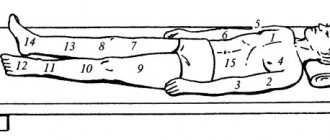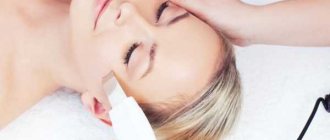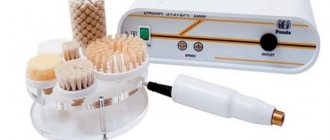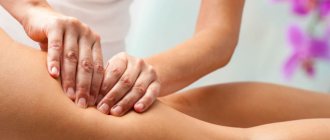Regular skin and toe care has become commonplace for women. Previously, pedicure was not the fastest and most enjoyable procedure. Classical techniques require steaming, cutting off layers of the epidermis and cuticle, and manual grinding, which often ends in injury. The modern approach is safe, even for those with sensitive skin.
What is a hardware pedicure?
The presented foot treatment technique can have two meanings. The options for what a hardware pedicure means include hygienic care or medical manipulation. The procedure provides not only an aesthetic aspect, but also a solution to most existing foot problems:
- corns;
- cracks;
- calluses;
- severe roughness of the sole;
- ingrown nails;
- thickening of the plates;
- onycholysis;
- fungus (auxiliary procedure) and others.
Hygienic hardware pedicure
The described type of manipulation is intended for systematic foot care. Dry pedicure makes the skin soft and smooth, helps to gently and painlessly get rid of rough areas. The process also involves thorough nail treatment. Hardware hygienic pedicure involves giving them the correct length and shape, removing the cuticle, and polishing the surface. After the procedure, you can apply the desired coating; gel polish applies especially well.
Medical hardware pedicure
This technology was developed for medicinal purposes. Dry hardware pedicure is prescribed for fungal infections of the feet, peeling, destruction and thickening of the nail plates. It is the optimal way to treat all types of calluses, including deep core injuries and old cracks. Hardware pedicure is indispensable in the treatment of diabetic foot. It guarantees absolute hygiene and safety of leather processing.
What is better - a hardware pedicure or a trimmed one?
Experienced craftsmen have not practiced the classical approach with steaming baths and sharp tools for a long time. When deciding which is better, a hardware pedicure or a classic one, it is important to be guided not only by habit and personal preferences, but also by objective arguments. The trimming technique is outdated, it is not safe and does not allow you to achieve the most “clean” result. Hardware pedicure has clear advantages:
- accuracy;
- absence of discomfort and risk of injury, cuts;
- sterility;
- long-term effect;
- better treatment of sensitive and hard-to-reach areas;
- slow growth of the epidermis and cuticle after the procedure.
The main advantages of hardware manicure
- Safety is one of the main and significant advantages of hardware manicure. The cutters almost completely eliminate the possibility of damage to the nail plate and cuticle, so after the procedure there are no burrs, wounds, cuts or cracks through which infection can occur. In addition, the absence of the need to steam the skin eliminates the development of fungus.
- During a hardware manicure, you can perfectly polish the nail and rid it of ribbing. On a flat nail plate, the polish looks completely different.
- Hardware manicure is painless. It allows you to carefully, delicately and quickly remove the cuticle. The result lasts up to two weeks, and if you regularly moisturize and nourish the skin, it can reach up to a month.
- Thanks to the soft effect on the nail and the soft effect on the nail, delamination of the nail plate is prevented, which often happens with a classic manicure. Nails acquire smoothness and a beautiful shade, and the cut looks well-groomed and elegant.
- Having a manicure and pedicure machine will allow you to save your budget. On average, a manicure in a beauty salon costs 1,500 rubles, and a pedicure – 2,000 rubles. Just imagine how much you can save by doing the procedure at home.
What is needed for a hardware pedicure?
It is important for beginning craftsmen to decide on a budget and shopping list in advance. Depending on the goals of the activity in question, a set for a hardware pedicure may consist of a minimum number of items (home use), or a long list of tools (professional activity). The standard kit should include:
- apparatus;
- cutters;
- antiseptic solution;
- towels (fabric for home, disposable for clients);
- brushes;
- pusher spatula or orange sticks;
- keratolytic – softener of the upper layer of the epidermis;
- remover and cuticle oil;
- non-greasy moisturizer;
- spray;
- disposable gloves and masks.
Machine for hardware pedicure
A high-quality router is the key to safe and correctly performed manipulation. This is the most important thing that is needed for a hardware pedicure, so you should consider the purchase of a machine thoughtfully, without unnecessary savings. The power of the milling cutter must be at least 40 watts. Even if you plan to do a hardware pedicure at home, just for yourself, there is no point in buying less intense machines. They simply don't create enough force to process the foot. The recommended number of revolutions per minute is 10-20 thousand, a reverse reverse function is required. Good options:
- Beurer MP 100;
- Saeshin Brilliant White;
- Gess 631;
- Strong 210;
- Marathon 3 Champion.
What cutters are needed for a hardware pedicure?
Most of the machines sold come with a set of drills and grinders, but each master creates his own set, which is convenient to work with. To perform a hardware pedicure at home, at first, basic cutters will be enough. Later, you can purchase additional attachments to suit your individual needs. Necessary cutters for hardware pedicure (of different diameters and hardness):
- cylinder (with longitudinal notches, perforated);
- truncated and standard cone;
- ball;
- flame;
- needle;
- felt, silicone polisher;
- sand caps (disposable).
Tips and recommendations from a podologist
- Do not use cosmetics before performing a hardware pedicure - they can cause the cutters to slip, which will complicate the specialist’s work.
- After a pedicure, use the products that the doctor recommends to you - this way you can maintain the effect of the procedure for a long time.
- A hardware pedicure procedure should only be performed by a qualified specialist with a medical education - this is the only way to guarantee the positive effect of the procedure and its safety.
How to do a hardware pedicure?
The speed and quality of manipulation can only be improved with experience. You can watch video tutorials on how to perform a hardware pedicure step by step, or ask an experienced nail technician to show you the procedure. There is no need to rush in the first few sessions; it is better to “bet” on the quality of the treatment. Hardware pedicure step by step for beginners:
- Wash your feet, treat them with an antiseptic and wipe dry.
- Adjust the length of your nails. Shape them into a truncated cone. You will need to use a brush periodically.
- Remove cuticle with a ball. It can first be softened with a remover and lifted with a stick or pusher.
- Clean the “pockets”, ridges, remove the pterygium with a needle and flame.
- Polish the plates with a silicone or felt pad.
- Lubricate the skin of the feet with keratolytic and leave for 5-10 minutes.
- Wipe off any remaining product with a towel and dry.
- Use a coarse sand cap to work through the roughest areas.
- To avoid discomfort, you need to move from the heel to the toes, without lingering in one zone; it is better to return to it again if necessary.
- Use a fine abrasive cap to polish the leather until it is pinkish-yellow, soft and smooth.
- Treat the fingers and the space between them with a truncated cone, first blue, then red.
- Brush off the “sawdust” with a brush, remove any remaining keratolytic with a spray bottle of warm water, and wipe your feet dry.
- Apply cuticle oil to your nails.
- Lubricate the skin with cream.
- Give a foot massage.
Rules and stages
To figure out how to do a pedicure correctly, you need to study all the rules and stages of the procedure. At home, step-by-step instructions consist of:
- Steaming foot bath.
- Treatment of heels using a machine and tweezers.
- Treatment of cuticles and nails using files and softening agents.
- Apply nourishing cream to the feet.
- Treating the nail plate with a disinfectant and coating it with varnish.
- In professional salons, the procedure also includes a foot massage.
Everything that is included in the pedicure procedure is easy to do and takes up to 1 hour.
Steam bath
Before you start treating your feet, you need to prepare them for a pedicure and soften the rough skin. Immersing your feet in water is the most popular way to steam out dead skin. To do this, pour warm water into a plastic bath, dip your feet into it and steam it. You can first add essential oils, soda or other products to the water. Foot baths are:
- Antibacterial - against odor and fungal diseases. Add 4 tbsp to the water. l. soda
- Toning to strengthen nails. Sea salt, peppermint oil and essential oil are mixed and added to the water.
- Softening. Add 4 liters of apple cider vinegar to the water. The duration of the procedure is no more than 10 minutes.
- Exfoliating. Pour table salt into the water, stir and add 2 liters of hydrogen peroxide. The duration of the procedure is 2-3 minutes.
- Relaxing. Tincture of calendula and chamomile is added to the water. This solution has a good disinfectant effect.
Heel treatment
You can remove rough skin from the heel using a grater and a machine. For very neglected feet, a machine is used; if the heel is in normal condition, then a grater is used. Processing process:
- Machine. It is better to use a machine whose blade is made of surgical steel, since this material has good wear resistance. The product is equipped with additional blades. After steaming, the feet are thoroughly dried and the foot treatment begins. The movements are smooth and easy in the direction from the edge to the center of the heel. In this case, you must not put pressure on the machine. Rough areas are treated additionally. At the end of the procedure, the feet are immersed back in the bath and polished with a special file. Then take it out and coat it with cream.
- Grater. Graters are chosen with a wooden handle and double-sided coating. Such products have one side hard, the other soft. The coating can be plastic, pumice, stainless steel or nickel. Using a laser, notches are made on the surface, which gives it roughness. After steaming the legs, the treatment is carried out with the hard side of the grater. The direction of movement is towards the center of the heel, starting from the sides and back. Then the feet are immersed in water, steamed again, taken out and treated with the soft side of the grater. At the same time, the treated area is increased.
If you don’t have a grater or machine, you can effectively remove rough skin using a scrub.
Treatment of cuticles and nails
The cuticle protects the nail from infections. The goal of a pedicure is to remove hangnails that grow after the cuticle dries. There are 2 ways to remove cuticles: trimmed and untrimmed.
- Edged. Nail trimming is done using stainless steel nippers. Apply a softening agent to the cuticles and leave on the nails for several minutes. Remains of the substance are removed with a damp cloth. The cuticle is removed with a spatula from the pedicure set. It is moved away with gentle movements, moving from the edge of the nail to the center. The layer of skin that has grown on the nail plate is cleaned with a tool with a sharp end. The procedure is done carefully so as not to scratch the plate. The skin around the nail is trimmed with forceps and lubricated with oil.
- Unedged. Keratolics are applied to the cuticle. When it softens, it is pushed away with an orange stick and smeared with a cuticle remover. It is then pushed back again and treated with oil. Orange sticks can be purchased with a tip made of multi-colored coating or rubber.
There is no need to steam your feet if you perform a hardware pedicure yourself. The treatment is carried out with grinding attachments and cutters, after softening the feet with special oils.
Applying varnish and cream
To soften the skin of the feet, they are treated with a cream with softening properties and only apply varnish to the nails. To prevent the polish from accidentally ruining the nail design on adjacent fingers, special pedicure separators are installed between them. Most often, gel polish is used to cover toenails. It is applied in two layers to the previously degreased surface of the nail plate. Cover the top with a layer of fixative.
Advantages
- This procedure is completely safe. Craftsmen most often use disposable attachments, while reusable ones are carefully processed after use. The attachments come in different sizes and shapes, thereby making it possible not to miss any area of the foot, including the most difficult ones.
- The therapeutic effect of the special compounds used.
- The skin is gently removed rather than cut off. Healthy areas are not injured.
- The procedure will need to be repeated much later (compared to a classic pedicure).
- The procedure is extremely comfortable and does not cause any discomfort.
- Effective in solving the problems of ingrown nails, hardening of nail plates, dry calluses and corns.










